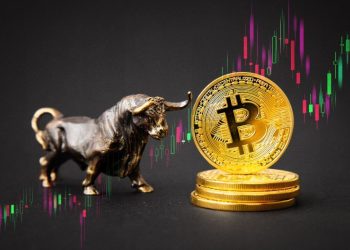
“What is it that happens in inflation? The unit of money suddenly loses its identity. The crowd it is part of starts growing and, the larger it becomes, the smaller becomes the worth of each unit. The millions one always wanted are suddenly there in one’s hand, but they are no longer millions in fact, but only in name.”
― Elias Canetti, Crowds and Power
Analysts at JP Morgan have attributed the rise in the price of Bitcoin to its greater appeal as a hedge against inflation. Inflation is literally wiping out the raises of those lucky enough to even have a good job — parents are worried about the price of milk for their kids. Investors can see that inflation is eating into the value of their assets with time, and rising inflation expectations make Bitcoin’s appeal more interesting as a long-term store of value.
Assets perceived as stores of value such as Bitcoin are rising as more and more investors discover that inflation levels were higher than expected. The Consumer price index (CPI) released by the U.S. The report released indicates that the cost of living in the States rose to 6.2% in October. The core inflation index, which strips out the food and energy component which are deemed to be more volatile rose by 4.6%. Analysts believe that these figures are modest at best. They do not represent the exact picture of things.
On its path, the Federal Reserve has described the situation as transitory. Implying that the figures would soon reverse to lower levels. Federal Reserve Chair Jerome Powell stated that the global economy is yet to fully recover from corona virus-related restrictions and supply chain bottlenecks.
Bitcoin prices, as a result, have gotten to record levels going at the $69,000 price level. By this, it is rallying close to 140% this year. In trying to explain the recent gains, market analysts cited a number of new developments ranging from anticipation around the taproot upgrade to the latest inflation figures. How these could lead to greater interest in Bitcoin.
Again, ongoing ETF approvals in the United States have increased clarity on coordinated regulatory reforms. As a result, there is greater insight into digital assets, and more people are able to take advantage of them through the ETFs. Also, the upcoming taproot upgrade will be the biggest upgrade to Bitcoin in 4 years. The upgrade will give greater transaction privacy in addition to efficiency.
On a weekly time-frame, BTC/USD closed above $63,300 on Sunday after having printed 2 weekly Doji candles in the previous weeks. The market has transitioned from indecision to action as prices threaten to jump into all-time high territory within the span of three weeks. But despite the positive development, bitcoin is technically in a range until it can close a daily candle above the previous all-time high set on October 20th.
The technical target of the falling wedge has technically been met, and it remains to be seen whether bulls have enough fuel in the tank to propel prices above the $70,000 level on the second attempt to new highs.
Notably, the weekly time frame is primed and ready to go to the next psychological target, with the $74,000 level representing a mere 10% move from $67,000. As price-discovery inches higher and higher, seemingly massive moves in fiat terms will increasingly represent smaller values percentage-wise. It’s important to retain perspective in these parabolic times.
Bitcoin’s net unrealized profit/loss is not within the vicinity of exhaustion. In fact, it looks primed to start running again. Unlike the last run-up to all-time highs where prices ‘front-ran’ on-chain fundamentals, the current move higher is slower and more deliberate. Bitcoin is appreciating in a sustainable manner within a healthy uptrend. If this sustainable trend continues, it could be some time before warning signs appear. Analysts like Will Clemente have long called for an imminent supply squeeze, which is due to hodler behavior and increasing demand. In this case, the fireworks haven’t even started yet.
Mainstream adoption of Bitcoin among investors and governments around the world has helped to buoy the value of Bitcoin to astronomical levels. It has dominated almost 50% of the total market cap of cryptocurrencies combined. Bitcoin’s current market capitalization is $1.16 trillion. This is more than double the combined market capitalization of the two largest financial service companies- JPMorgan and Visa. The market cap (mcap) of JPMorgan is $503.24 Billion, and that of Visa is $538.44 billion. Even Ethereum, with a market cap of $538.44 billion, was also higher than JPMorgan Chase.
It is also noteworthy that the rate of growth of crypto companies like Celsius is greater than what any bank has been able to make. In Celsius’ latest AMA session, its CEO Alex Mashinsky announced the growth numbers. Within a year, Celsius has grown from $1Billion to $30 billion. A similar trend can be seen across the board.
Companies in the Crypto and Defi industry have witnessed tremendous growth. In the process, Celsius Network has delivered more than $1 Billion in yield to its community. These are feats that no traditional financial institution has been able to achieve.
Although comparing cryptocurrencies and companies may be similar to comparing apples with oranges as crypto is a peer-to-peer software system while companies operate for-profit and have investors who want to gain on their stocks. However, digital currency is the 9th biggest tax asset by market capitalization globally. These assets include public companies, precious metals like gold, crypto, and exchange-traded funds ETFs.
In the assets category, gold was the highest rallying $11.5 trillion in market capitalization. The capitalization of Bitcoin was higher than businesses like Facebook, Berkshire Hathaway, Walmart, and so on. The gains have also trickled down across altcoins. In the past couple of days, Solana recorded maximum growth among the top 10 cryptocurrencies. This was followed by a 26% growth in Polkadot. Meme coins such as Dogecoin reported a growth of 0.89%. However, Shiba Inu declined by close to 13%.
Investments into crypto funds and assets were recorded as $1.47 billion as the total crypto assets under management AUM reached a new record of $79.2 billion. The increase in investments and AUM came after the growth witnessed in Bitcoin prices, Bitcoin features, ETF approvals and the listing of two bitcoin investment products.
JP Morgan released a report of its publication in the past week which focuses on alternative investment forecasts including cryptocurrencies. The report predicts that the long-term expectation of Bitcoin was 146,000 dollars. The short-term price prediction by a JP Morgan analyst was $73,000.
Chairman and CEO of Duquesne Family Office LLC, Stan Druckenmiller, discussed value investing last week at the Boston investment conference. Formerly a managing director at Soros fund management, he was responsible for funds of asset value up to 22 billion dollars. According to Forbes, his personal net worth is $6.8 billion dollars.
Druckenmiller stated that the bond market is in a bubble, and so everything else is also in a bubble. The current bubble is not a narrow one like the.com bubble people try to compare the situation with what happened in 1999. That was a bubble in technology.
For value investors, there is value out there, but not many are able to identify it based on their methodology. Druckenmiller revealed that he had invested in Bitcoin and believes that it is an attractive store value that could do better than gold. In June this year, he invested millions in Bitcoin after he got a call from a hedge fund manager Paul Tudor Jones about it. Paul Jones himself apparently had invested in Bitcoin and was backing the assets to perform better than gold as a hedge against inflation.
By a continuing process of inflation, the government can confiscate, secretly and unobserved, an important part of the wealth of their citizens. — John Maynard Keynes



















